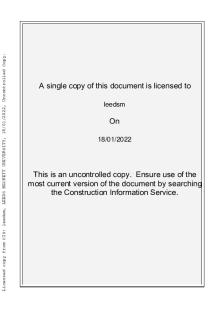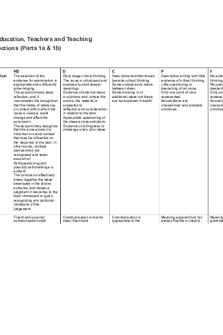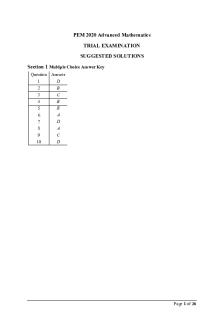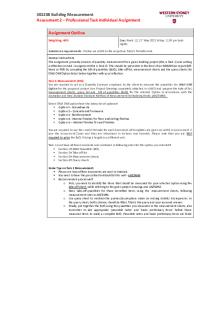Marking criteria - dfsdf - Cierre Foro PDF

| Title | Marking criteria - dfsdf - Cierre Foro |
|---|---|
| Author | Ryan Corr |
| Course | Analysing Law |
| Institution | University of Leicester |
| Pages | 4 |
| File Size | 65.7 KB |
| File Type | |
| Total Downloads | 58 |
| Total Views | 130 |
Summary
dfsdf...
Description
Classification-based Assessment Criteria for Undergraduate Essays (formative and summative)
Classification: First Argument and Identification of Relevant Issues The submission identifies the relevant issues and answers the question explicitly and critically with a sophisticated level of clarity and logic detailed and perceptive analysis; credit will be given for originality of thought or approach . Knowledge and understanding Demonstrates comprehensive knowledge and insightful understanding of relevant principles and uses this knowledge logically and thoroughly ; drawing persuasive conclusions . Structure Excellent throughout, with a strong and efective introduction and conclusion ; discussion is organised, balanced and logical and based around clear arguments; points linked and ordered appropriately . Research Demonstrates excellent research skills by full use of recommended reading ; refers to primary sources and secondary sources as appropriate and relevant to the assessment of the issues ; demonstrating knowledge of recent developments, where appropriate . Writing and Referencing Demonstrates excellent communication skills in both writing style and presentation ; clear, confident, engaging, logical and persuasive style ; near faultless grammar and spelling; accurate and appropriate use of referencing conventions . Overall A first class submission answers the question fully and critically demonstrating extensive knowledge and insightful understanding. A first class answer is not a perfect answer; high standards will be rewarded even when every point is not mentioned . An exceptional submission which demonstrates outstanding analysis or use of materials should be marked in the 80s.
Classification: 2(1) Argument and Identification of Relevant Issues The submission identifies the relevant legal issues and answers the question with a very good level of clarity and logic; very good analysis . At the lower end of the range, points will not have been explored fully while minor aspects may be missing . Knowledge and understanding Demonstrates very good knowledge and understanding of the relevant principles; uses this knowledge logically and thoroughly; some of the subtleties may have been missed when considering the more complex issues . Structure Very good throughout with a very good introduction and conclusion ; discussion is organised, balanced and logical Research Demonstrates very good research skills by use of most of the recommended reading ; reference to primary and secondary sources as appropriate and relevant to the assessment of the issues.
Writing and Referencing Demonstrates very good communication skills in both writing style and presentation; employs a clear, logical and on occasion persuasive style; makes occasional typographical, grammatical or referencing error. Overall A 2(1) submission demonstrates a very good command of the relevant legal issues and a very good ability to answer the question, engaging critically with the relevant materials . At the lower end, the submission demonstrates a good grasp of the above descriptors evidenced through a good ability to answer the question analytically with the relevant sources; not all issues may have necessarily been completely explored.
Classification: 2(2) Argument and Identification of Relevant Issues The submission identifies the relevant issues and answers the question with a competent level of clarity and logic; reasonable analysis. At the lower end of the range, there may be more description and issues and/or sources which are less relevant to the answer . Knowledge and understanding Demonstrates competent knowledge and understanding of the relevant principles and uses this knowledge reasonably; there may be gaps and/or minor misunderstandings . Structure Reasonable introduction and conclusion that may be too brief or too long; internal sections may be of varying length, or structure may lack logic or linking; tendency to lack clarity in presentation of ideas; tending to be information-led and descriptive rather than argument-led and discursive . Research Competent use of sources with perhaps more reliance placed on textbooks than academic journal or cases or statutes, as appropriate. Writing and Referencing Competent writing style and presentation but the submission may contain general and / or descriptive statements which are not evidenced or balanced ; there may be less consistency or precision with grammar, punctuation, citations and referencing . Overall A 2(2) submission demonstrates a competent command and understanding of the relevant issues and a reasonable ability to answer the question. Depth and breadth of critical analysis were satisfactory but could be improved .
Classification: 3rd Argument and Identification of Relevant Issues The submission demonstrates a basic command and synthesis of the relevant issues but does not answer the question fully or sufficiently analytically; some issues may not be fully explored and the submission might not have distinguished between relevant/irrelevant issues and/or sources; limited analysis and significant descriptive content; lacking in coherence and inconsistently linking content to the question . Knowledge and Understanding Basic knowledge and understanding of the relevant principles but gaps in knowledge and unease with principles, rules and cases (as appropriate); authorities may be lacking; clarity more limited when using the relevant law or principles . Structure Ideas not presented in a clear and logical way; structure mostly information-led; role of introduction and conclusion not fully grasped . Research Basic use of sources with perhaps heavy reliance placed on textbooks rather than journal articles, cases or statutes as appropriate; limited or lack of evidence of use of recommended reading . Writing and Referencing Basic writing style which would benefit from improvement for clarity, coherence and/or fluency; sentences may be poorly constructed; citations and references may be omitted or include significant inaccuracies; insufficient proofreading. Overall The submission demonstrates a basic command of the subject matter. While there is awareness of some of the relevant law and principles, coverage, understanding and analysis are limited .
Classification: Fail Argument and Identification of Relevant Issues The submission does not demonstrate sufficient command of the relevant issues and does not answer the question substantively; limited or lack of references to the relevant principles or sources; little or no analysis . Knowledge and Understanding Inadequate knowledge and understanding of the relevant principles; authorities are limited or absent . Structure Limited or absent introduction, structure and conclusion; poor presentation of ideas . Research Very limited or no evidence of reading.
Writing and Referencing Unsuitable writing style and referencing; lack of clarity, coherence and / or fluency; presence of significant grammatical and punctuation errors; citations and references may be absent or very poorly presented; evidence of lack of proof reading. Overall The submission fails to demonstrate a basic command of the relevant issues. The paper does not answer the question adequately , show sufficient knowledge of the subject or understanding of the relevant principles.
General Note
The descriptors or criteria above do not necessarily all have to be present in one category to achieve that grade (for example, a paper marked as a first may have excellent argument, knowledge and research, but the structure could have been improved and the style of referencing may not be fully compliant). The marker will undertake an overall assessment taking into consideration all the marking criteria and on balance, will award a grade that reflects the criteria within the band available (for example 60-68 or 40-48)....
Similar Free PDFs

Final Report Marking Criteria
- 1 Pages

Marking criteria - unknown drug
- 4 Pages

ECON 1145-Marking Criteria- May 2021
- 14 Pages

UKCA Marking Marking of Steel
- 21 Pages

Selección de personal - dfsdf
- 12 Pages

Marking rubric
- 1 Pages

Chirkut 2 - dfsdf
- 2 Pages

Hind Swaraj-1 - dfsdf
- 6 Pages
Popular Institutions
- Tinajero National High School - Annex
- Politeknik Caltex Riau
- Yokohama City University
- SGT University
- University of Al-Qadisiyah
- Divine Word College of Vigan
- Techniek College Rotterdam
- Universidade de Santiago
- Universiti Teknologi MARA Cawangan Johor Kampus Pasir Gudang
- Poltekkes Kemenkes Yogyakarta
- Baguio City National High School
- Colegio san marcos
- preparatoria uno
- Centro de Bachillerato Tecnológico Industrial y de Servicios No. 107
- Dalian Maritime University
- Quang Trung Secondary School
- Colegio Tecnológico en Informática
- Corporación Regional de Educación Superior
- Grupo CEDVA
- Dar Al Uloom University
- Centro de Estudios Preuniversitarios de la Universidad Nacional de Ingeniería
- 上智大学
- Aakash International School, Nuna Majara
- San Felipe Neri Catholic School
- Kang Chiao International School - New Taipei City
- Misamis Occidental National High School
- Institución Educativa Escuela Normal Juan Ladrilleros
- Kolehiyo ng Pantukan
- Batanes State College
- Instituto Continental
- Sekolah Menengah Kejuruan Kesehatan Kaltara (Tarakan)
- Colegio de La Inmaculada Concepcion - Cebu







